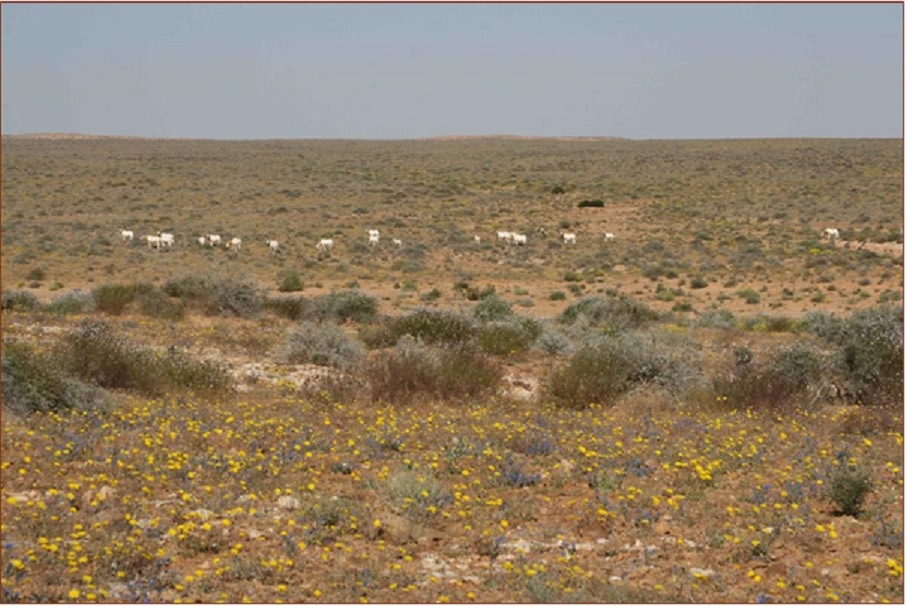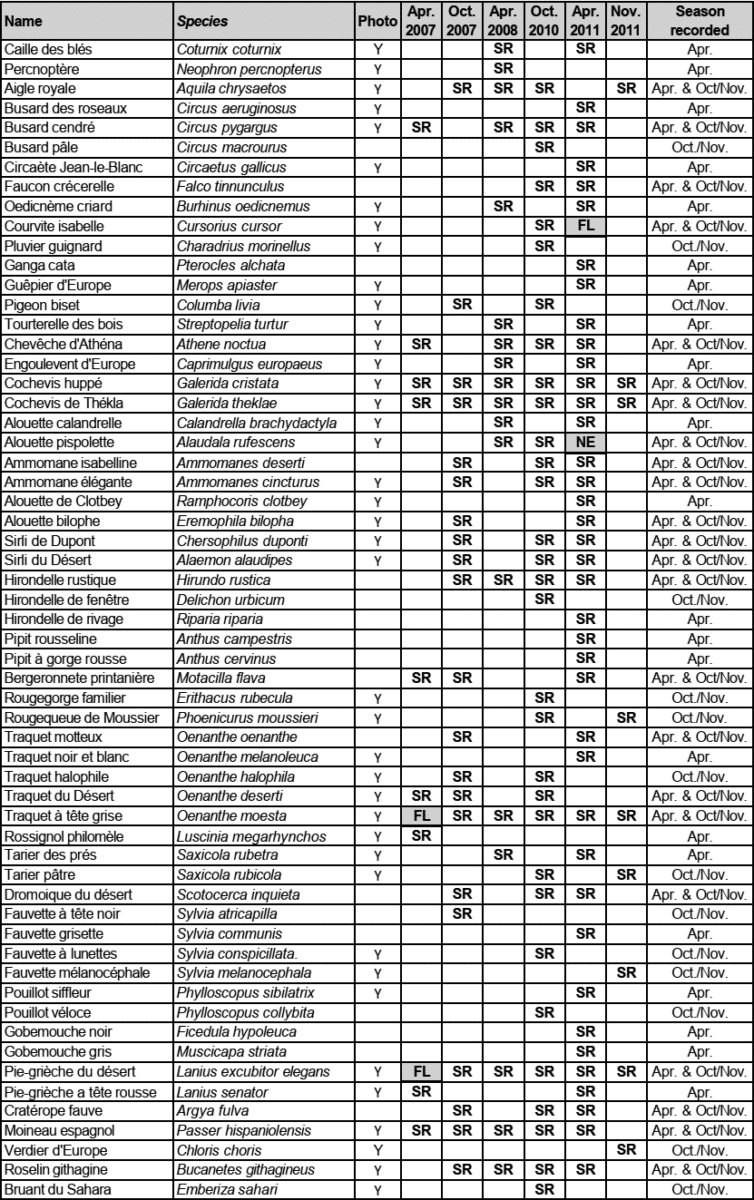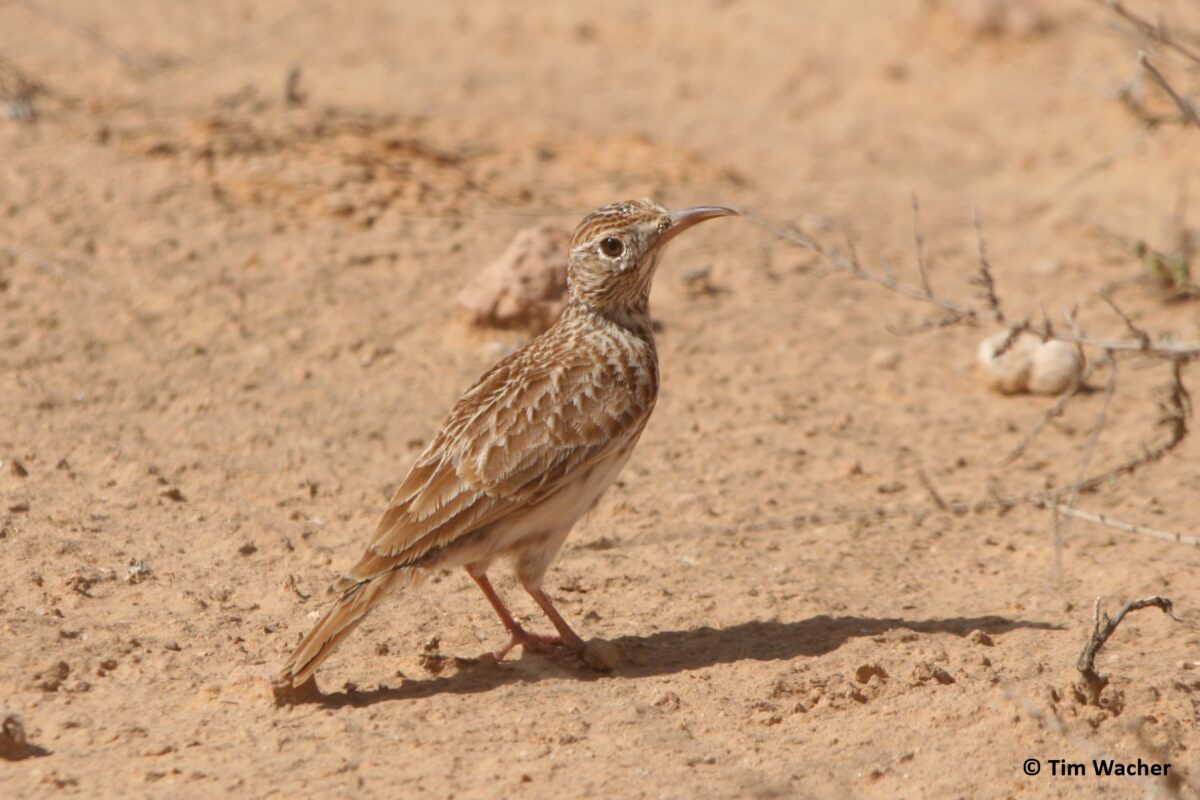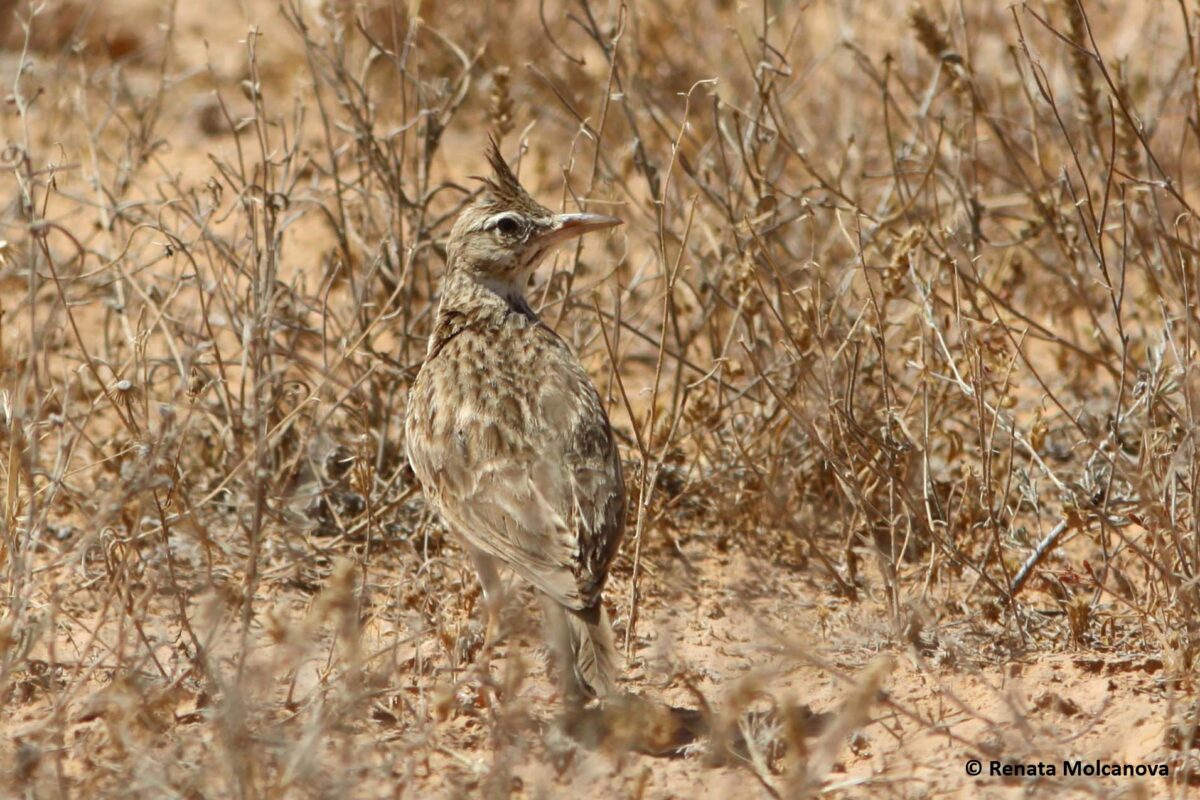The authors from the Zoological Society of London report their bird observations at Sidi Toui National Park made during six surveys (in 4 years). Although the main focus of the surveys was to monitor the oryx and gazelle populations, their ornithological records were nevertheless very important as they added new information about the birds of the park. These could be very useful for the site managers and other parties interested in the park’s birds.
Bird observations at Sidi Toui National Park, Tunisia
Renata Molcanova & Tim Wacher
Zoological Society of London, UK
PDF version of the article (Note that 22 of the 24 bird photos are included only in the PDF. The same for the authors’ email addresses).
Suggested citation:
Molcanova, R. & Wacher, T. 2021. Bird observations at Sidi Toui National Park, Tunisia. MaghrebOrnitho, https://magornitho.org/2021/04/birds-sidi-toui-tunisia/
Résumé
Les résultats de l’enregistrement opportuniste des espèces d’oiseaux au cours de 6 visites dans le Parc national de Sidi Toui, qui est situé dans la zone de steppe présaharienne du sud-est de la Tunisie, contribuent à l’élaboration d’une liste officielle pour cette aire protégée. Les 59 espèces détectées durant cette étude comprennent 6 espèces nouvelles dans la catégorie « espèce limitée à un biome » non répertoriées parmi les 13 espèces de cette catégorie dans l’évaluation initiale du parc national comme une ZICO (Zone importante pour la conservation des oiseaux). La diversité des migrateurs ainsi que les espèces nicheuses et résidentes avérées et potentielles fournissent ensemble une preuve claire du bénéfice que tire la biodiversité au sens large de la conservation de ce site mise en œuvre par la Direction générale des forêts tunisienne. Les principaux résultats comprennent la présence régulière de rapaces tant migrateurs que visiteurs indiquant une source de proies localement élevée, l’enregistrement du Sirli de Dupont Chersophilus duponti dans une aire protégée tunisienne et la présence pendant la saison de reproduction des 10 espèces d’alouettes connues pour habiter le sud de la Tunisie dans cette zone. Le PN de Sidi Toui intègre avec succès la gestion des intérêts culturels traditionnels, avec la conservation des antilopes menacées au niveau international tout en protégeant un échantillon de référence d’un habitat et d’une région où la biodiversité est gravement affectée par les niveaux élevés de surpâturage par le bétail. Des recherches supplémentaires sur l’avifaune fourniront une liste d’espèces plus complète et des preuves supplémentaires confirmant la grande valeur de ce parc national.
Abstract
The results of opportunistic bird species recording at the Sidi Toui National Park, classified as an Important Bird Area in the pre-saharan steppe zone of south-eastern Tunisia, provide a contribution to development of a formal species list for the park. The 59 species detected include 6 additional biome-restricted species not listed among the 13 biome-dependent species cited in the original IBA assessment for the national park. The diversity of migrants, plus proven and potential breeding species and residents together provide clear evidence of the wider biodiversity benefit provided by conservation management implemented by the Tunisian ‘Direction Générale des Forêts’ at this site. Key results include the regular presence of migrant and visiting raptors indicating a locally elevated prey base, documentation of Dupont’s lark Chersophilus duponti within a Tunisian protected area, and the breeding season presence of all 10 lark species known to inhabit southern Tunisia within this localised area. Sidi Toui NP successfully integrates management of traditional cultural interests, with conservation of internationally threatened antelopes while protecting a representative baseline for a habitat and region where biodiversity is otherwise severely impacted by high livestock grazing levels. Further research on the avifauna will provide a more complete species list and further evidence affirming the high conservation value of this National Park.
Introduction
Sidi Toui National Park lies in south-eastern Tunisia in the Governorate of Medenine. Centred on N32°41’40”, E11°14’41”, it is 40 km south of the nearest town at Ben Guerdane, and 140 km south of the tourism centres on the island of Djerba (Fig. 1). The 63 km2 (6315 ha) park, created in 1991, is managed by the Direction Général des Forêts (DGF). It conserves a representative zone of Mediterranean dwarf shrub steppe and its associated wildlife and protects the environment around a cluster of 14 ancient religious sites (Marabouts) on the low hills of Djebel Sidi Toui (178 m.a.s.l.), at the centre of the park. General access to the park is managed by the DGF. Each year in mid- October, pilgrims from Tunisia and neighbouring countries traditionally visit the park for 2-3 days to participate in a festival celebrating the saints associated with the Marabout sites (Souissi 2008). Sidi Toui National Park is classified as an Important Bird Area (IBA) (Amari & Azafzaf 2001, BirdLife International 2020a, b) on the basis that it is thought to hold a significant component of bird species largely restricted to two biomes: the Mediterranean North Africa biome and the Sahara-Sindian biome.

Climate: The park lies in the pre-saharan arid Mediterranean zone. Summers can be extremely hot (>45 °C reported) and winter temperatures down to 5 °C. Annual rainfall rarely exceeds 100 mm, mainly falling between October to April, but is unpredictable and variable with occasional wetter years. There is no natural permanent surface water, but small short-lived rain-pools may form in rocky areas after showers. The area can be affected by hot dry sirocco winds in any season, but which can be particularly strong in the spring periods, bearing dust and sand from the Sahara.
Vegetation: Notable plant associations include the dwarf shrub Rhanterium suaveolens and the tall grass Stipa lagascae on the plains; the hill slopes support several woody shrub species such as Periploca laevigata, Rhus tripartitum, Gymnocarpus decander, Ziziphus lotus and Lycium arabicum, providing shelter. On sand sheet accumulations shrubs such as Retama retam and various grasses, including Aristida sps., Stipagrostis sp. and Pennisetum sp. are present. In frequent dry periods the vegetation appears uniform and rather grey, but in spring an array of flowering forbs and herbs such as Anvillea radiata, Echium sp., Daucus sp., Rumex sp. and Matthiola sp. contribute to a spectacular mosaic of rich colour (Fig. 2).
Management: The park is protected by a 36 km double fence-line around the perimeter to exclude livestock and protect larger wildlife from illegal hunting. This has resulted in significantly increased vegetation cover and diversity (Tarhouni et al. 2014, 2017) and as a result the park now stands out clearly from the surrounding landscape in standard satellite imagery (Nasa Earth Observatory 2008), making its location and limits self-evident on Google Earth (Fig. 1).
Four permanently manned ranger posts guard the entry point gates and a visitor centre (Ecomusée) has been constructed in 1993 in the interior. Access around the park is via a network of established off-road tracks, most comfortably traversed using 4×4 vehicle. Two look-out towers (mirador) have been created on elevated points to provide extensive views over the habitat and scenery. Water troughs and shelters have been installed to support the population of oryx in 1999.
Wildlife: Amongst larger mammals, the park supports a small indigenous population of dorcas gazelle Gazella dorcas. Porcupines Hystrix cristata, Cape hares Lepus capensis and red fox Vulpes vulpes are also present as well as Golden jackal (Canis aureus), which following genetic evidence are now often called African Golden Wolf C. anthus (Karssene et al. 2019). Visitors are likely to encounter a growing population of Scimitar-horned oryx Oryx dammah at large in the park, and a small captive group of exceedingly rare slender-horned gazelles Gazella leptoceros. Both these species are present as part of Tunisia’s national effort to conserve the most threatened large wildlife of the Saharan and sub- Saharan regions. Reptiles are less well documented but desert monitor Varanus griseus and horned viper Cerastes cerastes are among those confirmed present. Here we focus on the bird life of the park. The observations reported were made opportunistically during a series of short routine visits to monitor the oryx and gazelle populations made between 2007- 2011. This species list is not comprehensive, but it is intended as a contribution to the development of a formal bird list for the National Park

Methods
Bird species were recorded opportunistically during six visits of 10–14 days each, made in 4 years between 2007 and 2011. The observations were made during the northern spring and autumn periods only, involving 3 visits in April, two in October and one in November. Although April represents a period of elevated breeding activity, the seasonal sample is restricted with limited coverage of the autumn migration period. As bird monitoring was not the focus of the visits, no formal bird survey methods or population counts were used and we assume that under-recording of bird species affects the results. This has been partially explored by applying a species richness estimator (Jacknife 1, EstimateS, Colwell 2013) to the species discovery rates obtained.
Results
The list of 59 species detected in this limited sample is given in Table 1, which also indicates months in which each species was recorded and the 41 species for which record photographs are available. All 24 images included in this document were taken by the authors in Sidi Toui National Park.
Estimation based on extrapolating the discovery rates implicit in Table 1 (see methods) indicates that these data support an estimate of c. 80 species (95% c.i. 70-90 species) that might be expected in total during the April and Oct-Nov sample period from this level of survey effort. Twenty-three species were recorded in both spring and autumn, 22 species were recorded in spring only and 14 species in autumn only.
Direct evidence of breeding was recorded from four species. A recently fledged Red-rumped wheatear, a prominent and characteristic resident species at Sidi Toui NP, was photographed on 17/04/2007. Great grey shrike fledglings were observed on 18/04/2007. A lesser short-toed lark nest with three chicks was found on 22/04/2011. Two cream-coloured courser fledglings were running with adults also on 22/04/2011. Following the national status assessments of Isenmann et al. (2005) at least an additional 20 species in Table 1 may be considered potential breeders based on presence in suitable habitat and season.
In separate years, fresh corpses of a probable nightingale on 14/04/2007 and one year later at a nearby location a whinchat on 01/04/2008 were found lying among vegetation on the ground in near identical condition strongly suggesting they had been partially swallowed then rejected by snakes.

Discussion
Analysis of the 6 species list samples in Table 1 confirms the expectation that the combined list reported here is far from complete for the reserve. Extension of recording to all months of the year, and application of specific bird survey methods is needed and will certainly result in detection of additional species. Probably well beyond the 70-90 species predicted from extrapolation of data derived here from low intensity surveys in limited periods of the year only. The more important result is that the species found highlight the successful role Sidi Toui National Park is playing in conserving arid land biodiversity in southern Tunisia. The regular presence of raptor species, particularly Golden eagle, and good numbers of harriers on passage, are indicators that the protected vegetation is also supporting a significant prey base of small mammals, including hares, plus insects and reptiles. In season, Montagu’s harriers may be seen daily, usually travelling well apart in ones and twos, actively hunting as they pass through; marsh harriers and pallid harriers behave similarly, though are generally less frequent. Golden eagles were consistently present and certainly attracted to the area to hunt. We have not seen evidence that golden eagles are nesting at Sidi Toui and the low hills do not provide obvious nest sites. But the rich vegetation and hills probably do provide important landmarks for migrating raptors such as short-toed eagles and Egyptian vultures.
The species list provides further support for the IBA status of Sidi Toui National Park. The park was originally classed as an IBA on the basis of eight species considered restricted to the Mediterranean North Africa biome, and five restricted to the Sahara-Sindian biome (Amari & Azafzaf 2001). This updated list adds three new species to the Mediterranean North Africa component: thick-billed lark, Dupont’s lark and spectacled warbler; and three species are also added to the Sahara-Sindian biome dependent group: bar-tailed lark, streaked scrub warbler and trumpeter finch.

All 10 lark species known to be inhabiting southern Tunisia (Cocker 2005, Isenmann et al. 2005) were confirmed simultaneously present in Sidi Toui National Park in the breeding season. Dupont’s lark, listed as Near Threatened in the IUCN Red List (Birdlife International 2020c), is represented at Sidi Toui by the more rufous eastern sub-species C. d. margaritae. So far as we are aware these observations provide the first confirmation of Dupont’s lark under protection within a Tunisian National Park.
Snakes and monitor lizards are widely acknowledged as significant predators of bird nests. The discovery of corpses of adult whinchat and nightingale both apparently partially swallowed by snakes, suggests direct predation by species such as horned vipers may be a relatively elevated threat for adult small migrants in this habitat, where they are obliged to shade and feed on or near the ground in the low vegetation. The predation risks are especially higher during spring when these small migratory birds arrive at the National Park depleted and tired after a long desert crossing.
We also note that at least four species in this short list have been subject to significant taxonomic reassessment in recent years. In consequence, alternative names exist in available identification literature for some quite prominent species. North African populations of great grey shrike have been affected this way (Olsson et al. 2010, Birdlife International 2020d). Although some crested larks show notably long bills at Sidi Toui, genetic research suggests these are not the same as the long-billed ‘Maghreb lark’ of Morocco (Guillaumet et al. 2006, 2008). The full species status of Maghreb wheatear relative to the Mourning wheatears further east is also debated (Schweizer & Shirihai 2013). We have assigned an observation of a black-eared wheatear to the Eastern black-eared wheatear Oenanthe melanoleuca (a pale-throated individual), recently shown to be a separate species to western black-eared (or Spanish) wheatear O. hispanica (Schweizer et al. 2018). We note also the mildly red-capped appearance of greater short-toed larks encountered at Sidi Toui, consistent with North-west African populations assigned to C. b. rubiginosa; another variable species subject to genetic investigation. There is growing recognition of endemism among North African bird populations (Isenmann & Thévenot 2018, 2020) and Sidi Toui NP holds several species of interest in this context.

These results add Dupont’s lark and Egyptian vulture to Pallid Harrier as species at conservation risk documented to use the park. We did not find or hear of any evidence of one key species for the area, the African Houbara Chlamydotis undulata during this survey period (see Birdlife International 2020b), emphasising the need for more focused bird survey work. Sidi Toui National Park is of particular interest in successfully integrating protection of a place of cultural importance, with national projects for conservation of extremely threatened antelopes (Molcanova 2006, Molcanova & Wacher 2011) and providing a representative and rare island of protected vegetation and biodiversity. The associated bird community shows a high proportion of biome-dependent species, which also indicate how this protected location is supporting small mammal and insect populations. Sidi Toui NP is particularly well-placed to assist migrant bird species on an important flyway between the Palearctic and sub-Saharan Africa. Achieving a more complete list of Sidi Toui National Park’s avifauna will add further evidence of the importance and value of this site.
Acknowledgements
We thank the Direction Générale des Forêts in Tunis, for permission to work at Sidi Toui NP and support throughout. At Sidi Toui National Park we thank all the Park staff for assistance and frequent warm hospitality. We particularly remember Mons. Ameur Mertah, former Conservateur of the park, who informed and inspired many visitors with his deep knowledge and care for the landscape and wildlife of Sidi Toui. Support for the visits to monitor oryx at Sidi Toui NP was provided by the Sahara Conservation Fund, the Mohamed bin Zayed Species Conservation Fund and the Convention on Migratory Species. We also thank Abdelkader Jebali for translating the abstract of this note and Mohamed Amezian for contributing very helpful information and comments.
References
Amari, M & Azafzaf, H. 2001. Tunisia. Pp. 953-973 in L. D. C. Fishpool and M. I. Evans, eds. Important Bird Areas in Africa and associated islands: Priority sites for conservation. Newbury and Cambridge, UK: Pisces Publications and BirdLife International (BirdLife Conservation Series No. 11).
BirdLife International 2020a. Country profile: Tunisia. http://www.birdlife.org/datazone/country/tunisia. Checked 28/09/2020.
Birdlife International 2020b. Important Bird Areas factsheet: Sidi Toui. Downloaded from http://www.birdlife.org on 28/09/2020
BirdLife International 2020c. Species factsheet: Chersophilus duponti. Downloaded from http://www.birdlife.org on 13/09/2020.
BirdLife International 2020d. Species factsheet: Lanius excubitor. Downloaded from http://www.birdlife.org on 21/09/2020.
Cocker, M. 2005. Birding Tunisia – off the beaten track. African Bird Club Bulletin 12: 56-2.
Colwell, R. K. 2013. EstimateS: Statistical estimation of species richness and shared species from samples. Version 9. Persistent URL, purl.oclc.org/estimates
Guillaumet, A., Pons, J-M., Godelle, B. & Crochet, P-A. 2006. History of the Crested Lark in the Mediterranean region as revealed by mtDNA sequences and morphology. Molecular Phylogenetics and Evolution 39: 645-656. https://doi.org/10.1016/j.ympev.2006.01.002
Guillaument, A., Crochet, P-A. & Pons J-M. 2008. Climate-driven diversification in two widespread Galerida larks. BMC Evolutionary Biology 8: 32. https://doi.org/10.1186/1471-2148-8-32
Isenmann, I., Gaulthier, T., El Hili, A., Azafzaf,H., Diensi, H. & Smart, M. 2005. Oiseaux de Tunisie / Birds of Tunisia. Société d’Études Ornithologiques de France (SEOF), Paris.
Isenmann, P. & Thévenot, M. 2018. Endémisme et différentiation taxonomique chez les oiseaux nicheurs terrestres en Afrique du Nord. Alauda 86: 117-153.
Isenmann, P. & Thévenot, M. 2020. Endemism in terrestrial birds of continental North Africa. Go-South Bull. 17: 161-184.
Karssene, Y., Chammen, M., Li, F., Eddine, A., Hermann, A. & Nouira S. 2019. Spatial and temporal variability in the distribution, daily activity and diet of fennec fox (Vulpes zerda), red fox (Vulpes vulpes) and African golden wolf (Canis anthus) in southern Tunisia. Mammalian Biology 95: 41-50. https://doi.org/10.1016/j.mambio.2019.02.001
Molcanova, R. 2006. Update on the scimitar-horned oryx reintroduction in Sidi Toui National Park, Tunisia. In: Proceedings of the Seventh Annual SSIG meeting 2006, Douz, Tunisia. Sahara Conservation Fund, pp. 86–91.
Molcanova, R. & Wacher, T. 2011. Suivi scientifique des populations semi-captive d’ASS. Direction Générale des Forêts, Tunisie. Projet ASS CMS/FFEM Devis-Programme 2010-01. Part 2. Scimitar- horned oryx monitoring (PN Sidi Toui; RN Oued Dekouk; PN Bou Hedma) and Addax monitoring (PN Djebil). April 2011.
Nasa Earth Observatory 2008. Sidi Toui National Park Tunisia. https://earthobservatory.nasa.gov/images/35741/sidi-toui-national-park-tunisia
Olsson, U., Alström, P., Svensson, L., Aliabadian, M. & Sundberg, P. 2010. The Lanius excubitor (Aves, Passeriformes) conundrum—Taxonomic dilemma when molecular and non-molecular data tell different stories. Molecular Phylogenetics and Evolution 55: 347-357. https://doi.org/10.1016/j.ympev.2009.11.010
Schweizer, M. & Shirihai, H. 2013. Phylogeny of the Oenanthe lugens complex (Aves, Muscicapidae: Saxicolinae): Paraphyly of a morphologically cohesive group within a recent radiation of open- habitat chats. Molecular Phylogenetics and Evolution 69: 450-461. https://doi.org/10.1016/j.ympev.2013.08.010
Schweizer, M., Warmuth, V., Alaei Kakhki, N., Aliabadian, M., Förschler, M., Shirihai, H., Suh, A & Burri, R. 2018. Parallel plumage colour evolution and introgressive hybridisation in wheatears. Journal of Evolutionary Biology 32: 100-110. https://doi.org/10.1111/jeb.13401
Souissi, M. 2008. Le tourisme dans les parcs nationaux en Tunisie. Téoros 27(3): 79-84. https://journals.openedition.org/teoros/90
Tarhouni, M., Ben Salem, F., Belgacem, A. O. & Neffati, M. 2014. Impact of livestock exclusion on Sidi Toui National Park vegetation communities, Tunisia. International Journal of Biodiverstiy 2014: 620405 https://doi.org/10.1155/2014/620405
Tarhouni, M., Ben Hmida, W., Belgacem, A. O., Louhaichi, M. & Neffati, M. 2017. Is long-term protection useful for the regeneration of disturbed plant communities in dry areas? African Journal of Ecology 55: 509-519. https://doi.org/10.1111/aje.12381